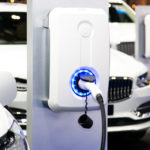Charging at home
Home charging for fleets can require a process to recoup costs for employees. From working with several councils, we’ve found that 60% of Council staff garage at home. Understanding the options for home charging, therefore, will be critical in the absence of a suitable public charging network. Typically, at home people can install a 3kW or 7kW charger; however, it is also possible to charge from a standard wall plug.
It is generally a simple exercise which only becomes complex if switchboard upgrades, wall penetrations or civil works are required.
There are several key benefits of home charging:
- Reducing the need for public charging
- Taking advantage of the low household electricity costs at night
- Ensuring that all electric vehicles are fully charged for the next day
- Reducing the demand for fleet facility infrastructure investments
There are also several challenges with respect to home charging that must be considered:
- Charging at night at home will not synchronise with daytime solar renewable energy provision unless there is a separate battery for the home or hydro/wind generation on the grid.
- Policy decisions must be made in terms of who pays for the installation of the charger, and what happens when staff leave Council or move house.
- It can create complexity in terms of the need to recoup costs.
- The correct electricity rate must be applied to the energy consumed for proper reimbursement. This may include varying time-of-use tariffs.
Reimbursements for infrastructure and electricity costs for home-based charging of fleet EVs can be considered as follows:
- Infrastructure
If the fleet decides to allow for home charging, then clear policy guidelines can ensure that home charging installation costs are fully reimbursed – including labour, electrical upgrades, charger installation and network service fees. - Electricity
When fleet vehicles are charged at home, there may be a need to track and reimburse electrical expenditures. Electricity consumption from EV charging can be measured in a variety of ways:
a. Odometer readings: a corporate cost per km could be established, which is seen as a fair reflection of the average cost per km. This would be the simplest way to manage the issue, given that employees may also charge at public charging stations.
b. Telematics: Making use of fleet vehicle telematics enables the company to track energy consumption by vehicle rather than charger. Setting up charging reports by location guarantees that the amount of electricity consumed at home can be tracked.
c. Smart or networking-based charging stations: Smart charging stations that are networked have the capacity to track electricity usage and provide reimbursement. Some networks enable for company accounts, allowing for use reports to be delivered directly to the company administrator. Additional capabilities such as access control and charge management may be available with networked stations.
d. Monitoring through digital meters: Electricity meters are commonly used to assess energy consumption for invoicing and/or monitoring purposes. The meter must be dedicated to the EV charging circuit or integrated with a smart home monitoring system in order to track only the EV load. However, there are some restrictions to this approach. If the charger is ever used by non-fleet vehicles, or if the meter is not connected to a dedicated EV-only circuit, consumption data for the fleet vehicle will not be accurate.
Given the large number of home garaged vehicles, it’s important for organisations like utilities, local governments , logistics companies or corporates to explore potential solutions to home charging including potential policy changes. There is also an opportunity to work closely with state and national government agencies and charging networks to create a network that assists Council’s fleet transition while giving networks greater financial certainty.

 State Government – EV Grants and incentives
State Government – EV Grants and incentives EV Fleet for Bus Operators
EV Fleet for Bus Operators EV Fleet for the Logistics Industry
EV Fleet for the Logistics Industry Vehicle to Grid – An Overview
Vehicle to Grid – An Overview